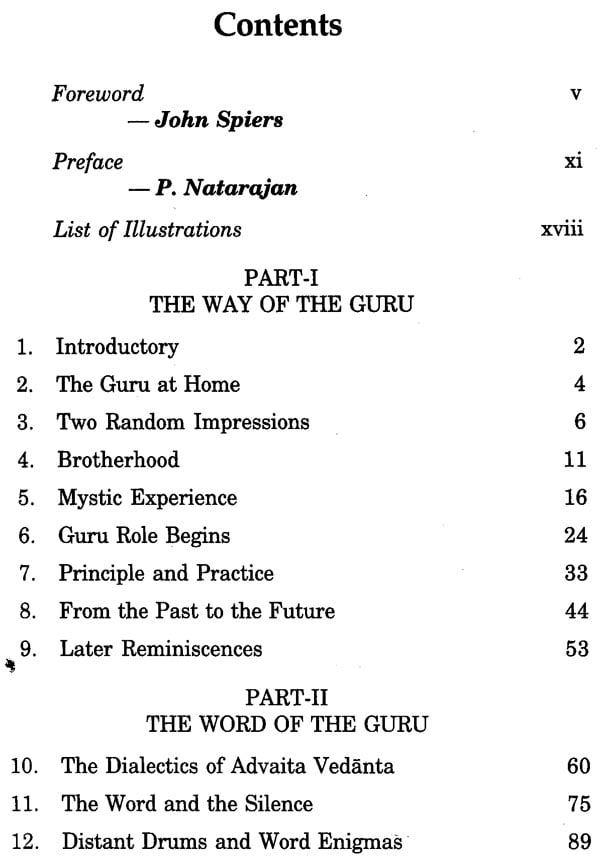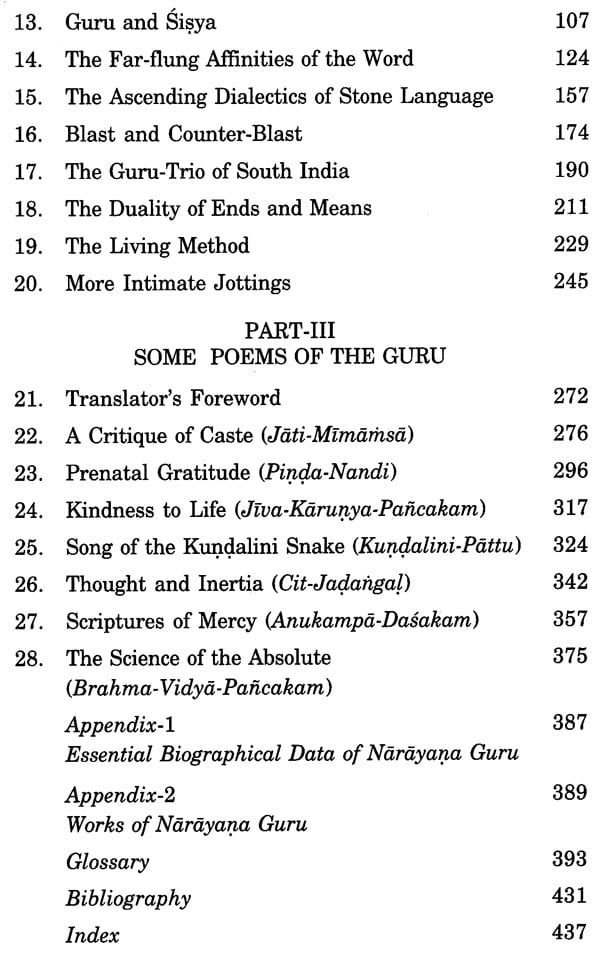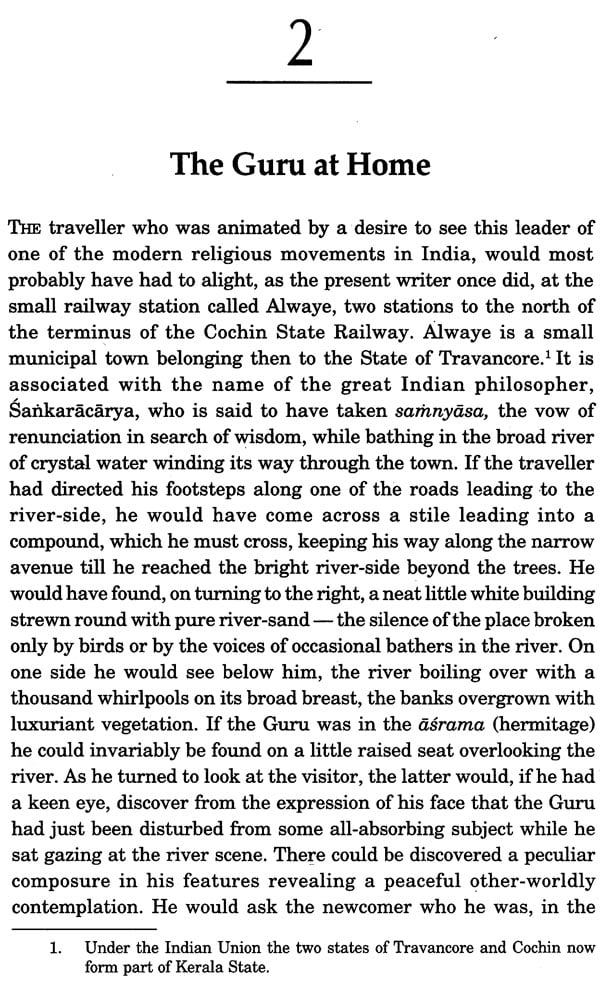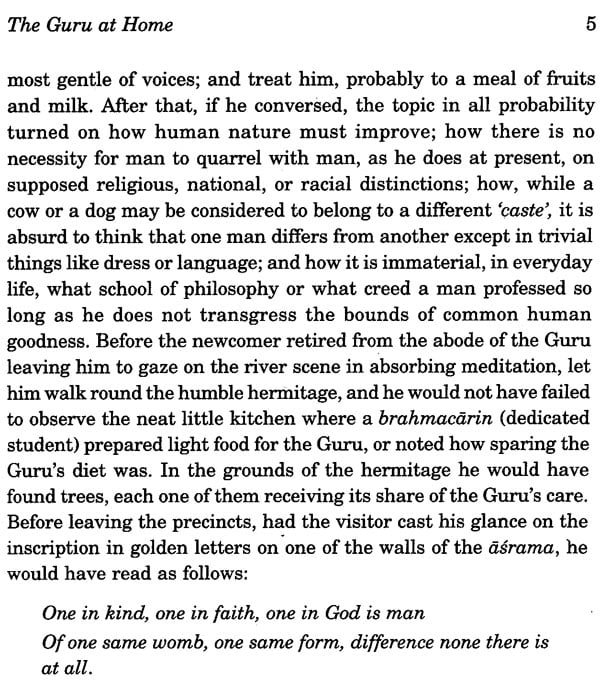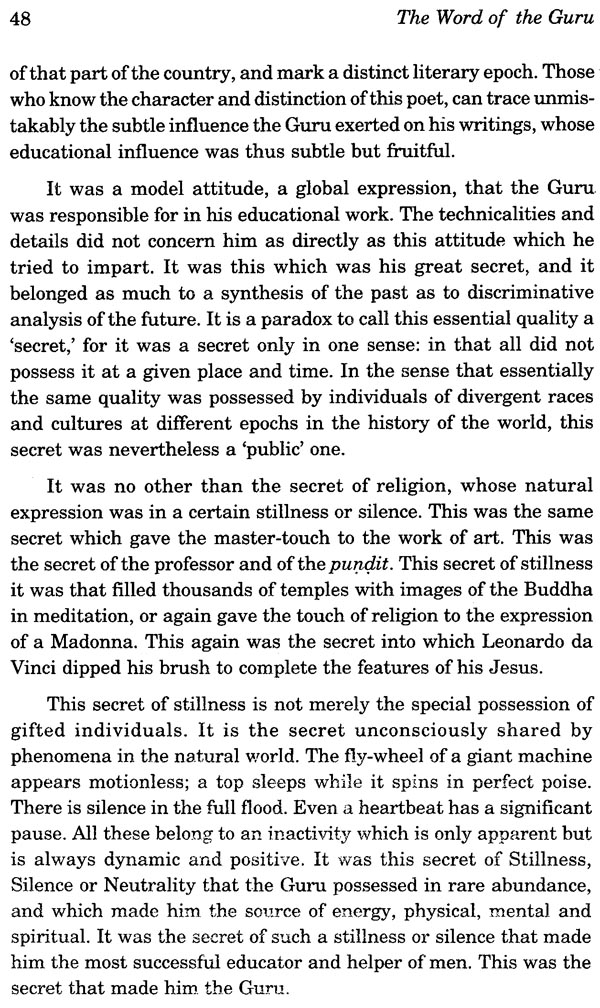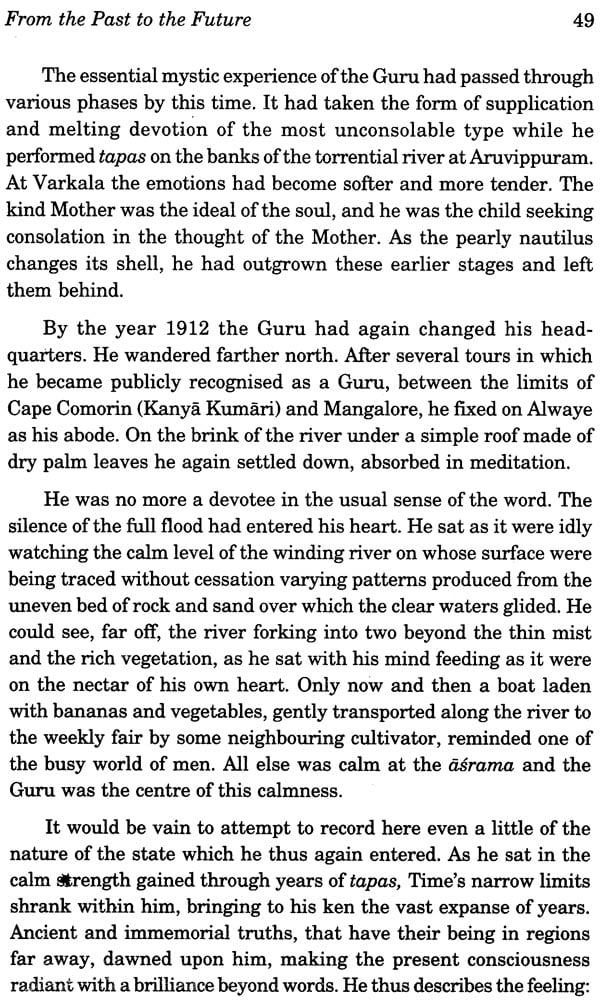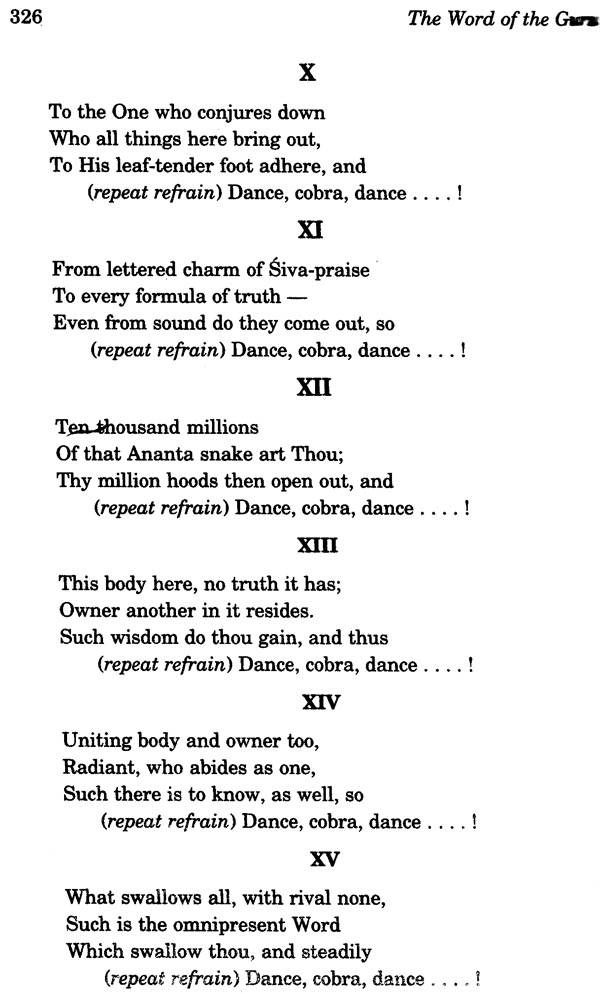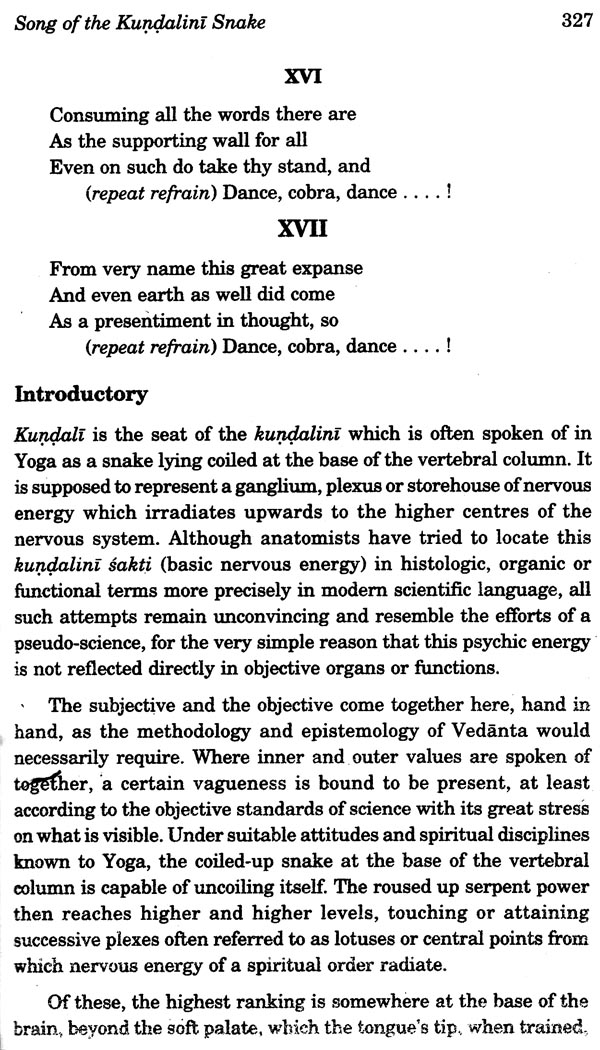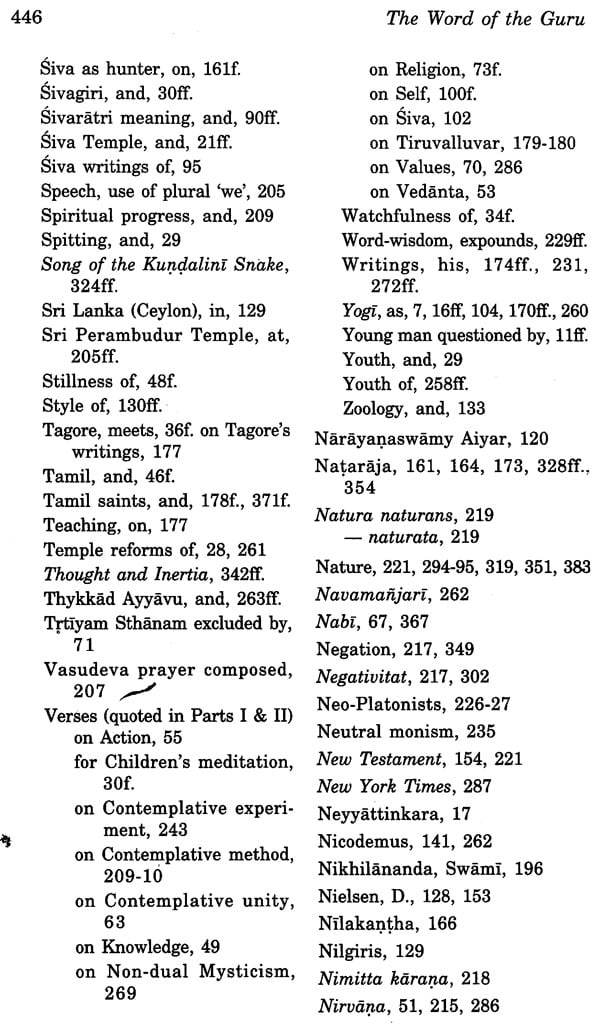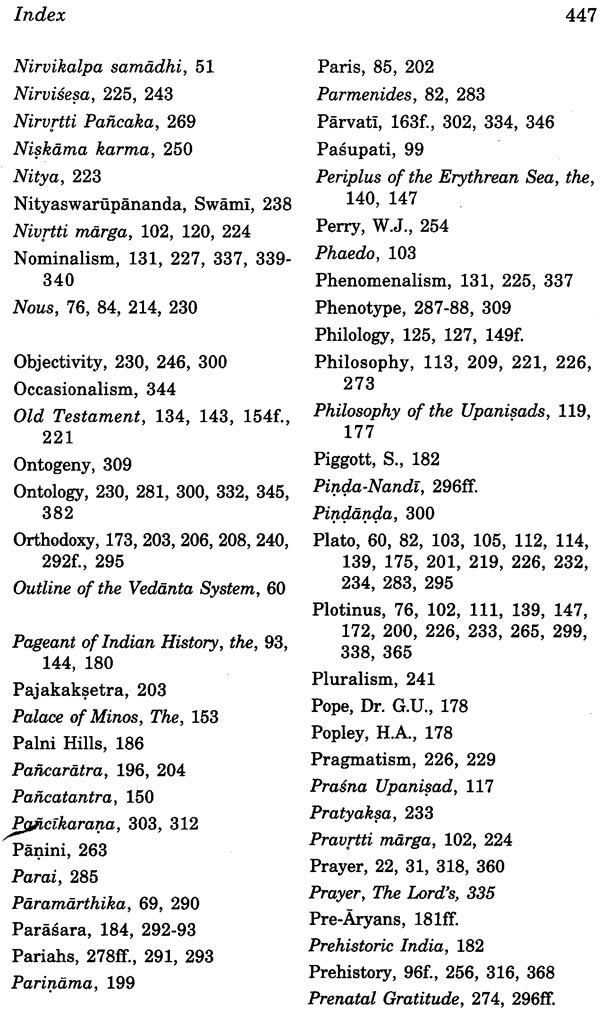
The Word Of The Guru : The Life And Teachings of Guru Narayana
Book Specification
| Item Code: | NAV862 |
| Author: | Nataraja Guru |
| Publisher: | D. K. Printworld Pvt. Ltd. |
| Language: | English |
| Edition: | 2017 |
| ISBN: | 9788124602416 |
| Pages: | 470 (17 Color and B/W Illustrations) |
| Cover: | HARDCOVER |
| Other Details | 9.00 X 6.00 inch |
| Weight | 840 gm |
Book Description
Maharaja Guru, the disciple successor of the Narayan Guru, uses the contemplative discipline which was characteristic of the Guru Narayan, and brings the Advaita Vedanta method into the forefront of global thought as understood today, introducing a new science of Wisdom Dialectics. Maharaja Guru’s scheme of correlation between science and mysticism amounts to an epochal advance in philosophy.
The Word of the Guru provides a quantity of original material for study, including fully annotated and carefully translated writings of Guru Narayana. It describes the physical and psychological conditions of South India with great brilliance. The spirituality of India is set forth here in its clearest terms, unambiguous and shorn of all limiting frontiers, suitable for readers in all parts of the world.
I am quite well aware that the mention of the word guru will probably cause some eyebrow rising, but not enough, I trust, to stop you from getting on with this book. Here you will find nothing escapist. Such religion as it presents is philosophically and psychologically interpreted rather than urging any creed or belief, least of all what is commonly called Hinduism. But when all that is said, I am aware of an archaic taste remaining. That cannot be helped. It belongs to the subject-matter. Indeed the pre-historic element evoked is a healthy reaction, fundamental, quite materialist or at least rebellious enough to satisfy the modern mind in revolt against the conventions of history. The majority of people have always been materialist. Here materialism is not rejected as a proper view in its proper place, but it is balanced by other aspects of human life.
This book represents the voice of the Guru. It is a solitary voice, recorded more or less against the stream of pressurised thought, both Indian and elsewhere. Its tone is as much foreign to India as to other lands. Certain old values lost to the world, had to be restated. The temper of modern India is flamboyant, nationalist, and in a hurry to exceed the dynamic Western world’s successes in the material sphere.
Hence most of what is written here is very little known in India itself. Yet I have no hesitation in affirming, after many years active association with Indian thought and current literature, that you will find in these pages the authentic spirit of the contemplative East. It is not due to any bias for south India on the part of the author that he indicates certain reasons why the contemplative spirit should persist in this far too little known corner of the world.
South India has seldom been in the news. Nothing sensational happens here. Ever since the days of the Moguls north India has held the stage. The inner life of India, that strange factor of contemplation, on the other hand, has naturally withdrawn to its safe preserves. Even an author such as W. Somerset Maugham, on his quest for a background for a novel about a Guru, chose Malabar. Nobody visiting south India can be insensitive to its heritage of leisure. The northern Indian should not feel any offence. He too has to wander into the Himalayan regions to find a parallel refuge for contemplation. No antagonism is implied. The far South disarms all opposition by its poverty, mildness, simple ways and its deep roots, both primordially instinctive and intellectually strong, penetrating further into the past than perhaps anywhere in the world, with the possible exception of China.
Everywhere, in India no less than in other parts of the world, there exists a psychological unrest and tension, which nobody seems to be able to cure. There is besides a natural scepticism against all panaceas, certainly when proffered by the headline experts in politics, economics, science, religion and philosophy. It would be too much to expect repeatedly misled readers to come to this book with any new hope. All the same, there is hope here. You will not get that sense of a ‘let-down’ after reading it. This work is about an Indian, its background is Indian, the philosophical language is mainly a survival of what has matured in India, and it is written by an Indian. All that notwithstanding, I cannot sufficiently emphasise the fact that its vision is global, beyond locality and circumstance. Its theme is not so much the biography of a great man, as the biography of a central value which might be called unitive understanding, happiness, and in India, Ananda.
As a help to the reader, something may be said here about the structure of the book.
In the first place the whole volume is intended to clarify a subject, which is the genuine spiritual tradition of India. Around this noble subject, so many spurious, uninformed and sensational ideas have gathered - from the lowest level of cheap novels even up to the highly rarefied platforms of professional punditry - that it is a feat in itself to have cleared away all this mass of accumulated inane, misleading, vulgar litter. At the same time this subject is obscure enough in its own surroundings to need the pointed attention of a peculiarly qualified intelligence to unravel and expound.
The Word of the Guru therefore is quite the reverse of occult journalism. I am breaking no confidences when I say that it was rejected outright by a well-known firm of publishers in London, because it was not sensational enough by such standards. The author scorns to play up to the debased taste of those who relish books about the mysterious East, miracles, fakirs, and the whole gamut of yogi tricks and stooge figures. Hollywood and colourful swamis can be left to cater for the lovers of mysteries. Commercial interest is not in the author’s taste. ‘Secrets’ can be sold by the esoteric organisations and the various yogis who trade upon the gullible.
Dr. Natarajan is one of the rare living authorities on Advaita Vedanta, which is the science and heart of the wisdom tradition of India. He has devoted his life to this subject. He is a philosopher who lives his philosophy, but he is not a ‘Professor’ of philosophy. He is too sincere to make good on a platform or to cut a charming figure in society. He himself is a guru. That is the long and the short of it. That qualification alone makes him and his book unique. In writing this volume he has done so in the only way possible, by cantering his subject-matter around a real living being, his own guru, in relation to whom he himself was a disciple.
The first section of this volume stands by itself, and readers will be found to observe a vast difference in style and method, as if it were written by a different personality. This is almost the ease, since not only is there a time-gap of over twenty years between its original publication and the remainder of the writing in this volume, but the mood of elation and youthful veneration has subsided to the self-assured certainty of philosophic maturity. In this first part, the Guru Narayana as a man is described with some emotion.
But in the second and larger portion of this book the Guru- figure assumes a greater status, perhaps less impressionistically, but all the more important on the immense canvas of history, and he may seem, at times, almost to dissolve into symbolic rank, as a principle of guru-hood. This is partly intentional. It is only by taking the particular Guru Naryana as a representative of a permanent, timeless guru model, as a typical example close to our own times, of the pure philosopher who stands, not for special view or argument, but for the principle of pure reason and wisdom of India, that the author can display with justice the meaning of guru-hood and guru- wisdom. In its full content this is only incidentally Indian, just as the guru is only incidentally the man who was the boy Nanu with certain parents and a certain environment on the West Coast of India. The universal value, the global vision, thus gets a chance to be represented.
In the third section, some examples are given of the literary works of the Guru Narayana - the ‘Word’ as it was given on different occasions to fit the needs of popular and special exigencies. Much of this will appear abstruse and peculiar for non-Indian readers because of the intricate and unfamiliar Indian background material and terminology. But at the same time this third section will be appreciated for this very reason as it has a flavour of its own, a sampling of an exotic south Indian dish, so to say. It conveys the real mental and spiritual conditions of south India.
From the list of the literary works of the Guru Narayana given at the end of the book, some idea of the vast material yet to be explored and annotated and commented upon will be noticed. It is Dr. Natarajan’s intention to do this. This is his service to his guru. Christ had St. Paul and a whole sequence of mystics in Europe to continue this labour. Lao Tzu in China had Chuang Tzu and other Tao writers fitted for the same expeditionary task. Mohammed’s commentators existed too in the form of the sufts. Plato and Aristotle were elaborated and understandable through the efforts of their linear successors such as Hypatia, Plotinus and Dionysius the Areopagite. The Zen masters in China and Japan had their aphoristic works interpreted by their disciples. Dr. Natarajan’s book is but the breaking of the ice in regard to his guru’s works. More will follow. The present is largely introductory and by no means a final statement. There are far more serious treatments ahead, relating to contemplation as a science of tremendous value to modern thought.
This is not to say that Dr. Natarajan is merely an elaborator of the Guru Narayatta. He has not only his own original contribution to the subject, but - without departing an iota from the Guru’s text he has himself revalued and restated, with what can only be called his own contemplative insight or yogic intelligence, many of the puzzling enigmas of applied philosophy.
Indeed, if I may be bold enough to say so, he has made what amounts to revolutionary discoveries in philosophic thought and practice. He has taken up that much-abused term dialectics and given it a synoptic meaning. He has shown how polarised ambivalences can be resolved at any level, from the personal to the collective, psychologically. He has brought contemplation out of the closed system of private individual life and shown it to be the sanest human solution for every possible contingent problem, social, historical, religious and philosophical. In all this he has not deviated from or abused the teaching of his own spiritual Teacher. On the contrary, he has continued the method which had such success with the Guru Narayana and former gurus. This method is logically clear and yet elusive enough to have puzzled the intelligence of all philosophers hitherto to bring down to understandable terms.
In preparing this book for publication, I have worried the author for six months over his terminology and his language, trying to put myself in the position of a lay reader to whom it is all new. This accounts for what may seem to the specialist in philosophical jargon, the banality of some of the footnotes. But the lay reader, for whom this book is meant as much as for the serious student, is not like Macauley’s schoolboy. The glossary too is meant mainly for non-Indian readers, but even Indian readers will find many a novel and rational rendering of some of the puzzling terms which are too often given a slipshod English equivalent.
Thus my part in this publication is that of a critic and literary finisher. Any unorthodoxy in style or language is mainly due to the subject-matter and the appalling paucity of English or almost any other modern European language, with the possible exception of German, when it comes to finding exact terminological equivalents for the highly perfected words in Sanskrit, Malayalam and Tamil. Contemplative psychologists have developed in these languages exactitude of precise technical terms to a degree bewildering and amazing for the newcomer, more than in any other language - not excluding scholastic or theological Latin and Greek. This process of accuracy of definition has a growth at least two or three thousand years old. From the philosophical point of view, or the psychological, Western languages in this respect are lisping a baby language. This is not said in disparagement of the enormous elasticity, fecundity and vigorous ability of Western languages to coin terms suitable for mechanistic description. But if new life is to flow into the world, not only must ancient peoples in Asian lands assimilate the language of modem science, the reciprocal or dialectical assimilation of the specialised psychological vocabularies of the East must be attempted by the West. That is a side-issue of some relevance which this volume may help to stimulate.
But I must leave the reader to discover other things of interest and value for himself. My role is that of an announcer, anxious now to step aside, to let the curtain rise, having, I hope, prepared you for a patient reading of an unusual and epochal book dealing with human understanding, and the welfare and happiness of us all.
What an excellent number your January number is I look forward to further instalments of word Narayana’s life. There are wonderful people in this wicked world still.
The celebrated French writer M. Romain Rolland also noticed the articles in his now famous work on the life of Ramakrsna, in which he admirably summed up the import and significance of the Guru’s life as follows:
Glasenapp does not say anything regarding the new religious manifestations in south India which are not negligible: such for example is the great Guru SrI Narayana, whose beneficent spiritual activity has been exercising its influence during the past forty years in the State of Travancore on nearly two millions of his followers (he passed away in 1928). His teaching, permeated with the philosophy of sankara, shows evidence of a striking difference of temperament compared with the mysticism of Bengal, of which the effusions of love (bhakti) inspire in him a certain mistrust. He was, one might say, a Jnanin of action, a grand religious intellectual, who had a keen living sense of the people and of social necessities. He has contributed greatly to the elevation of the oppressed classes in south India, and his work has been associated at certain times with that of Gandhi.
No doubt the reader will be aware of a difference in style and method between these chapters written more than twenty years before those that follow in the remainder of this volume. These early chapters were written unpremeditatedly, with very little intellectual planning, with the sole purpose of presenting something of the personality of the Guru, fresh from the anvil while he was still living, and before the intensity of the actualities of the Guru’s presence evaporated by lapse of time and the mellowing of memory. The attempt was then made to delineate in broad outline a first distance view of the whole of the Gurus personality, stressing perhaps certain emotional and intellectual highlights, including some of his personal traits in a rather sketchy, general way, and without too much emphasis on any deeper philosophical aspects.
The Guru passed away at Varkala after the first two chapters had appeared in print, while I continued to live and teach in Switzerland. My studies in individual psychology on the one hand, and on Vedanta and philosophy in general on the other hand, taken together with preoccupation with brick and mortar in connection with establishing two idealistic institutions called ‘Gurukulas’ in India, one at Fernhill, Nilgiris and the other at Varkala, Travancore, kept me occupied for nearly fifteen years thereafter.
Now that these years of necessary action have come to a natural close, I have been moved again to attempt the completion of my long cherished ambition of presenting the teachings and theoretical aspects of the Guru Narayana’s life in a form which I hope will be acceptable and understandable to seekers of truth in the West, as well as to those in the East, who are frying to comprehend, in terms of Western values, their own rare heritage of wisdom in revalued and restated language. The hospitality of the Gurukula founded by my friend, Harry S. Jacobsen, at the Schooley’s Mountains in New Jersey, U.S.A., in 1949, gave me just that needed quiet retreat and access to libraries and books which has made it possible to write with some seriousness.
In dealing with the present work and with future projects, I must take the reader into my confidence, so that the general aim intended here will be understood.
The personality of the Guru is of such a rare kind that it does not fit itself into the usual scheme of biography- As a personality he is elusive and enigmatic, and therefore hardly capable of being appreciated with the hasty publicity which even ephemeral figures get. But, on the other hand, as has always been the case with the teachers of the perennial wisdom, his deeper message with all its real values will persist, like a glowing subterranean fire, which will influence thought through time In writing the life of a Guru it is essential for all readers,
In writing the life of a guru it is essential for all readers particularly those outside India, to know not only the background of the personality, but the background which is the setting for the teaching, in which the wisdom has its first meaning. To that extent background details are relevant, enabling the reader to surmount the merely personal and rise into the region which might be described as the biography of the Word-wisdom.
I have three volumes altogether in mind, of which this is the first, and perhaps in some ways the most difficult to write. I have here retained the earlier impressions and pen-pictures which constituted my first presentation of 1928, and this, being a section v itself, can be regarded as a preliminary introduction to the second cart of this volume.
In the second part, as far as possible, I have attempted a rambling treatment of the whole subject-matter, lapsing where ever possible into personal anecdote, and intentionally and consciously refusing to confine myself to any conventions of style, or what might be called an academic form. Such liberties as I have taken in these matters may be excused in the present work which is only meant to introduce the person of the Guru together with his teachings grosso modo rather than by way of a ‘close-up.’ For the ordinary reader some of the terms, phrases and ideas may at first sight appear unduly heavy. The wisdom-philosophy was so much part and parcel of the life of the Guru that such initial terminology is unavoidable if a true picture is to be presented. The loading of heavy or unfamiliar expressions has not been done on purpose. The wisdom-teaching has been lost or has been confused with much vestigial or irrelevant matter, all of which needs reasoned clearing and a fresh restatement of relevant values made before the Guru and his Word can be understood in its authentic grandeur.
In the third part of this volume translations of some of the writings of the Guru Narayana will be found. These are only samples from the large body of writings left by the Guru. They have been selected and graded to illustrate some of the mystical yet always human values presented by the Guru.
The last of the selections on The Science of the Absolute or Brahma-Vidya, sets the limit, as it were, to this volume. This science requires deep and critical study, of which only a foretaste is provided here. The major literary works of the Guru were concerned with this science, and the two further volumes which I hope to publish later will deal with this in extenso.
In connection with this present work, my indebtedness to friends is great, both directly and indirectly, and I shall not attempt to enumerate them all here. Above all, it is to the Guru that I am mainly indebted, and in acknowledging his personality conceived in general terms I include all others who love wisdom. In this sense, I incline inclusively before all, in the One.
During the summer of 1949 I was in Paris still working at my manuscripts, translating and taking notes. I availed myself of the use of the library at the Musèe Guimet and also at the Institut de Civilisation Indienne at the Sorbonne. I frequented the lecture- rooms of the College de France and contacted thinkers such as Prof. O. Lacombe whose recent work, L’Absolu Selon le Vedânta (The Absolute according to the Vedanta), has been of considerable help to me. I have also had the benefit again of sitting in the study groups round Prof. Masson-Oursel. My indebtedness to these academic foundations of Paris has to be recorded here with gratitude. Such subjects as physiology, Assyriology, Egyptology, atomic physics and general philosophy interested me at Paris and to the various professors who have enlightened me I acknowledge my gratitude. The kindness, encouragement and hospitality of Madame L. Morin of Paris, who introduced me to the various intellectuals of that city is not to be forgotten.
In April 1951 I arrived back in India and reached the Gurukula at Fernhill, Nilgiri Hills in May. My friend and colleague John Spiers, with whom I had already established intellectual and, if I may say so, spiritual contact, for nearly five years, and who even substituted and deputised for me at the Gurukula there in my absence, was sufficiently interested and strangely well qualified took through the manuscripts I had brought back. Much editorial revision, additions, including many footnotes, and ordering to make the meanings more explicit are to be attributed to the labours of this friend who comes from that same part of the world from which originated John the Scot in the ninth century and whom I consider much as a Godsend in the context of the Word of the Guru. I have largely relied on him for all work requiring editorial sagacity and a sense of the public mind, from the stage of typing out the manuscripts in their final form to that of seeing them safely through Press.
These seem to be some of the eternal questions echoing and re-echoing through the ages within the heart of humanity. Some think the answer can be found in material comforts. Some search for the answer in books. Some sit in meditation trying to tune their life- breath in unison with the Great Knowledge. Some others ‘scorn delights and live laborious days.’ All these attain degrees of success.
Once in a hundred years, solitary among a hundred thousand, there arrives at the caravanserai of life one, at the sight of whose features the seekers instinctively arise from their varied occupations and greet him, and see in him and his ways a clear commentary, a silent interpretation, a radiant centre of all that they were seeking. He is able to dispel age-long doubt and darkness by his words: and the hearers smile and for a moment feel a strange happiness. Literature and art and science grow round his person. Historical events find a centre round which to turn.
Narayana Guru was one of such. He was one of those who followed in his life the ancient and immemorial programme of oriental saints and prophets. He left his home in search of Truth. He lived in lonely hill, cave or forest for years, unknown to men, performing tapas.1 He emerged from seclusion, having solved some great riddle in life and he wanted to give his solution to the world at large. Therefore, without any sort of hesitation whatever, he called himself a guru or Teacher. Penniless himself, he began to command an influence over rich and poor, educated and uneducated. People flocked to take the dust of his feet.
Today his words are recognised as a most modern echo of the ancient wisdom of the Orient. In him we had, combined once again, a bard who sang about the aspirations of the soul of man, a philanthropist whose one aim in life, night and day, was to devise ways to minimise human suffering, and a seer whose daily food and drink was the highest form of Truth.
Although out of reach of newspapermen and propagandists, this silent sage was the recognised spiritual leader of more than two million people in south India, to whom his word was more imperative than law. Within a period of less than a decade he had established more than one hundred places of worship on the west coast of India alone, which are day by day growing into centres of educational, philanthropic, and economic activity. Crowded meetings are held in which his name is the unifying element. His message to the people is the subject of weekly comment on many platforms, and scores of associations have been organised in various a-parts of south India to spread his ideals. By the spell of his name, young and old are seen to join hands in a common undertaking: rich and poor are seen to rub shoulders. It can be asserted that has set in motion a force which is bound to spread into a new impetus for the regeneration of India and the world.
Book's Contents and Sample Pages
